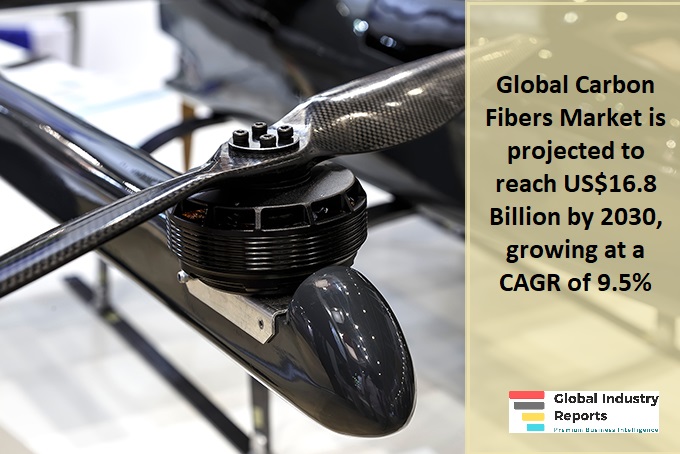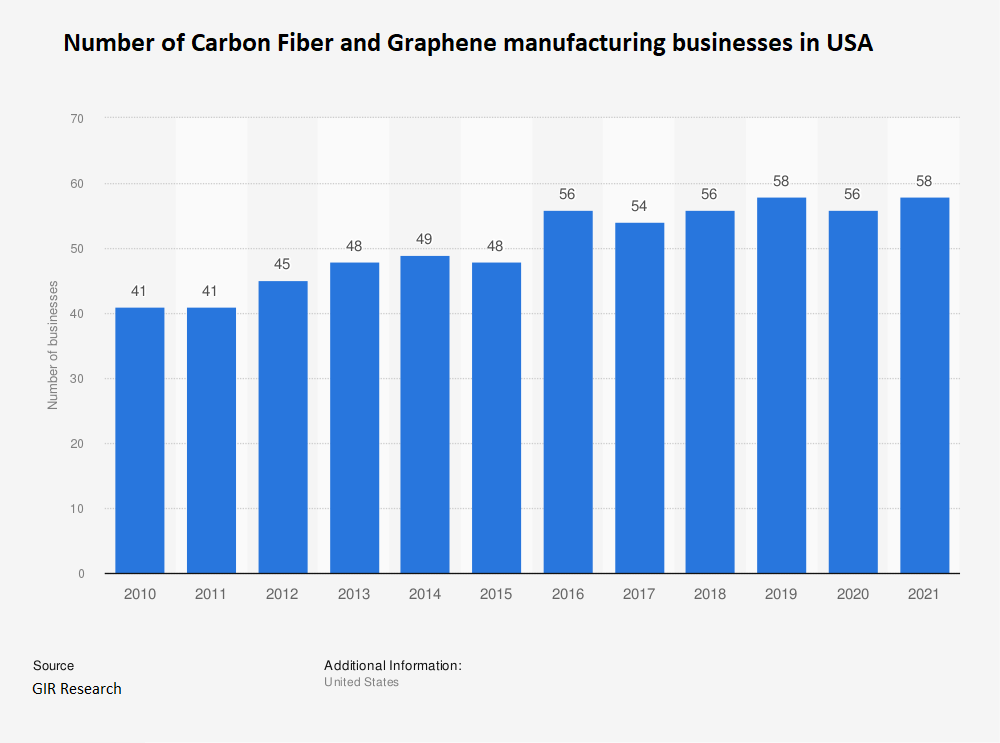Report Overview
- Understand the latest market trends and future growth opportunities for the Carbon Fibers industry globally with research from the Global Industry Reports team of in-country analysts – experts by industry and geographic specialization.
- Key trends are clearly and succinctly summarized alongside the most current research data available. Understand and assess competitive threats and plan corporate strategy with our qualitative analysis, insight, and confident growth projections.
- The report will cover the overall analysis and insights in relation to the size and growth rate of the “Carbon Fibers Market” by various segments at a global and regional level for the 2010-2030 period, with 2010-2021 as historical data, 2022 as a base year, 2023 as an estimated year and 2023-2030 as forecast period.
Description:
- In the changed post COVID-19 business landscape, the global market for Carbon Fibers estimated at US$8.1 Billion in the year 2022, is projected to reach a revised size of US$16.8 Billion by 2030, growing at a CAGR of 9.5% over the analysis period 2022-2030. Aerospace & Defense, one of the segments analyzed in the report, is projected to record an 8.2% CAGR and reach US$4.6 Billion by the end of the analysis period. Considering the ongoing post pandemic recovery, growth in the Automotive segment is readjusted to a revised 9.9% CAGR for the next 8-year period.
- The Carbon Fibers market in the U.S. is estimated at US$2.4 Billion in the year 2022. China, the world`s second largest economy, is forecast to reach a projected market size of US$2.9 Billion by the year 2030 trailing a CAGR of 8.9% over the analysis period 2022 to 2030. Among the other noteworthy geographic markets are Japan and Canada, each forecast to grow at 8.3% and 8.1% respectively over the 2022-2030 period. Within Europe, Germany is forecast to grow at approximately 7.5% CAGR.
MARKET DATA INCLUDED
- Unit Sales, Average Selling Prices, Market Size & Growth Trends
- COVID-19 Impact and Global Recession Analysis
- Analysis of US inflation reduction act 2022
- Global competitiveness and key competitor percentage market shares
- Market presence across multiple geographies – Strong/Active/Niche/Trivial
- Online interactive peer-to-peer collaborative bespoke updates
- Market Drivers & Limiters
- Market Forecasts Until 2030, and Historical Data upto 2015
- Recent Mergers & Acquisitions
- Company Profiles and Product Portfolios
- Leading Competitors
The Report Includes:
- The report provides a deep dive into details of the industry including definitions, classifications, and industry chain structure.
- Analysis of key supply-side and demand trends.
- Detailed segmentation of international and local products.
- Historic volume and value sizes, company, and brand market shares.
- Five-year forecasts of market trends and market growth.
- Robust and transparent research methodology conducted in-country.
- Qualitative and quantitative analysis of the market based on segmentation involving both economic as well as non-economic factors.
- Provision of market value (USD Billion) data for each segment and sub-segment.
- Analysis by geography, region, Country, and its states.
- A brief overview of the commercial potential of products, technologies, and applications.
- Company profiles of leading market participants dealing in products category.
- Description of properties and manufacturing processes.
- marketed segments on the basis of type, application, end users, region, and others.
- Discussion of the current state, setbacks, innovations, and future needs of the market.
- Examination of the market by application and by product sizes; utility-scale, medium scale and small-scale.
- Country-specific data and analysis for the United States, Russia, China, Germany, United Kingdom, France, Japan, Israel, Saudi Arabia, South Korea, United Arab Emirates, Canada, Switzerland, Australia, India, Italy, Turkey, Qatar, Sweden, Spain, Belgium, Netherlands, Norway, Singapore, Egypt, Denmark, Austria, Vietnam, Brazil, Argentina, Mexico, South Africa, and others.
- Coverage of historical overview, key industrial development and regulatory framework.
- Analysis of competitive developments, such as contracts & agreements, expansions, new product developments, and mergers & acquisitions in the market.
- A look at the opportunities in the market for stakeholders and provide a competitive landscape of the market leaders.
Reports Scope and Segments:
| Report Attribute | Details |
| Market size in 2022 | US$8.1 Billion |
| Market size forecast in 2030 | US$16.8 Billion |
| Growth Rate | CAGR of 5.25% from 2022 to 2030 |
| Base year for estimation | 2022 |
| Historical data | 2015 – 2022 |
| Forecast period | 2023 – 2030 |
| Quantitative units | Revenue in USD million and CAGR from 2023 to 2030 |
| Report coverage | Revenue forecast, company ranking, competitive landscape, growth factors, trends, DROT Analysis, Market Dynamics and Challenges, and Strategic Growth Initiatives
COVID-19 Impact, Market Growth Trends, Market Limiters, Competitive Analysis & SWOT for Top Competitors, Mergers & Acquisitions, Company Profiles, Product Portfolios Market Size, Market Shares, Market Forecasts, Market Growth Rates, Units Sold, and Average Selling Prices. |
| Segments covered | Raw material, Fiber type, Modulus type, Product type, Application, End use and Region |
| Regional scope | North America; Europe; Asia Pacific; Latin America; Middle East and Africa and rest of the world |
| Country scope | United States, Russia, China, Germany, United Kingdom, France, Japan, Israel, Saudi Arabia, South Korea, United Arab Emirates, Canada, Switzerland, Australia, India, Italy, Turkey, Qatar, Sweden, Spain, Belgium, Netherlands, Norway, Singapore, Egypt, Denmark, Austria, Vietnam, Brazil, Argentina, Mexico, South Africa, and others. |
| Key companies profiled | 3M; Advanced Composites Inc.; Anshan Sinocarb Carbon Fibers Co., Ltd.; BASF SE; Celanese Corporation; Covestro AG; Cytec Solvay Group; Dalian Xingke Carbon Fiber Co.; Dow; DowAksa; DSM; ; Evonik Industries AG; Formosa Plastics Corporation; Hexcel Corporation; Hyosung Advanced Materials; Jiangsu Hengshen Fiber Materials Co., Ltd; Jilin Chemical Fiber Group Co., Ltd.; Kureha Corporation; Mitsubishi Chemical Carbon Fiber and Composites Inc.; Mitsubishi Rayon Corporation Limited; Nippon Graphite Fiber Co., Ltd.; Osaka Gas Chemical Corporation Ltd.; SABIC; SGL Carbon Group; Sinosteel Jilin Carbon Co., Ltd.; Solvay; Teijin Ltd.; Toho Tenax Co. Ltd.; Toray Industries INC.; Weihai Tuozhan Fiber; Zhongfu Shenying Carbon Fiber Co., Ltd.; Zhongheng New Material; ZOLTEK Corporation and others |
| Customization scope | Free report customization (equivalent up to 20 analyst’s working days) with purchase. Addition or alteration to country, regional & segment scope. |
| Report Format | PDF, PPT, Excel & Online User Account |
Report Segmented by:
By Raw Material Type:
- Pan-based carbon fiber
- Pitch-based carbon fiber
- Rayon based carbon fiber
By Fiber Type:
- Virgin carbon fiber
- Recycled carbon fiber
By Modulus Type:
- Standard modulus
- Intermediate modulus
- High modulus
By Product Type:
- Continuous carbon fiber
- Short carbon fiber
- Long carbon fiber
By Application Type:
- Composite
- Non-Composite
- Textiles
- Microelectrodes
- Catalysis
By End-use Industry Type:
- Aerospace & Defense
- Automotive
- Wind Energy
- Pipes & Tanks
- Sporting Goods
- Electrical & Electronics
- Marine
- Molding & Compounding
- Construction
- Others
By Region:
- North America
- Europe
- Asia Pacific
- Latin America
- Middle East and Africa
- Rest Of The World
Companies Covered in Report:
| 3M | Kureha Corporation |
| Advanced Composites Inc. | Mitsubishi Chemical Carbon Fiber and Composites Inc. |
| Anshan Sinocarb Carbon Fibers Co., Ltd. | Mitsubishi Rayon Corporation Limited |
| BASF SE | Nippon Graphite Fiber Co., Ltd. |
| Celanese Corporation | Osaka Gas Chemical Corporation Ltd. |
| Covestro AG | SABIC |
| Cytec Solvay Group | SGL Carbon Group |
| Dalian Xingke Carbon Fiber Co. | Sinosteel Jilin Carbon Co., Ltd. |
| Dow | Solvay |
| DowAksa | Teijin Ltd. |
| DSM | Toho Tenax Co. Ltd. |
| Evonik Industries AG | Toray Industries INC. |
| Formosa Plastics Corporation | Weihai Tuozhan Fiber |
| Hexcel Corporation | Zhongfu Shenying Carbon Fiber Co., Ltd. |
| Hyosung Advanced Materials | Zhongheng New Material |
| Jiangsu Hengshen Fiber Materials Co., Ltd | ZOLTEK Corporation |
| Jilin Chemical Fiber Group Co., Ltd. |
After Sales Support
- Every updated edition of the report and full data stack will be provided at no extra cost for 24 months.
- Latest 2022 base year report.
- Free Updated edition of 2023 every quarter without any hidden cost.
- No user limitation for the report. Unlimited access within the organization.
- Unrestricted post-sales support at no additional cost
- Free report customization (equivalent up to 10 analyst’s working days) with purchase. Addition or alteration to country, regional & segment scope
- Global Industry Reports will support your post-purchase for a period of 24 months to answer any of your queries related to the following market and to provide you any more data needed, for your analysis.
- Option to purchase regional or selected Chapters from the report.
Frequently Asked Questions:
- What is the growth rate of the global carbon fiber market?
- What is the valuation of the global carbon fiber market?
- Who are the major players of the global carbon fiber market?
- What is the restraining factor of the global carbon fiber market?
- What is the major driver of the global carbon fiber market?











